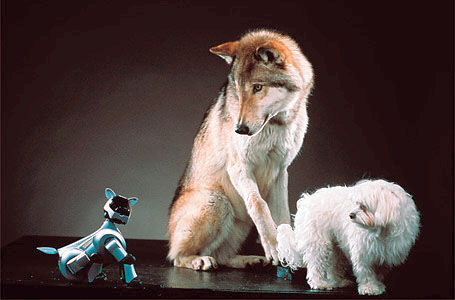Guess I'd better not tell Hope the Vicious what you said:
Posted on 12/21/2004 8:45:42 AM PST by PatrickHenry
The wide range of variety in domesticated dogs — from the petite Chihuahua to the monstrous mastiff — has powered a new view of what drives evolution.
Scientists have long known that the evolutionary changes that alter a species' appearance or create new species frequently occur in rapid bursts. One widely accepted theory holds that any evolutionary change results from a random switch of a single genetic unit within DNA.
These single-point mutations occur in about 1 out of every 100 million DNA sites each generation. This frequency is too low to cause rapid evolutionary change, assert John W. Fondon and Harold R. Garner, biochemists at the University of Texas Southwestern Medical Center at Dallas.
While examining human-genome data, Fondon found that small segments of repeated DNA sequences, called tandem repeat sequences, are frequently present in genes that control how an animal develops into its final appearance. Unlike single-point mutations, tandem repeat mutations occur when a cell's machinery for copying DNA makes a mistake and inserts a different number of sequence copies.
Such mistakes, which happen 100,000 times as often as single-point mutations, could alter an organism's appearance or function for successive generations.
"I was stunned by what I found," says Fondon. "It occurred to me that this might be a nifty way for [organisms] to evolve very rapidly."
To evaluate this hypothesis, Fondon and Garner looked for tandem repeat sequences in 92 breeds of domesticated dogs. For example, they examined a gene that determines nose length. They found that the number of times a particular sequence is repeated correlates strongly with whether a breed has a short or long muzzle.
Many researchers explain dog-breed diversity as the emergence of hidden traits in the genome. However, says Fondon, a more likely scenario is that genetic mutations occur in dogs at a high rate.
By comparing skulls of dogs over decades, Fondon and Garner found significant and swift changes in some breeds' appearances. For example, between the 1930s and today, purebred bull terriers developed longer, more down-turned noses.
Moreover, the researchers found more variation in tandem-sequence repeat lengths among dogs than they found in the DNA of wolves and coyotes.
These results suggest that dogs have experienced significantly higher rates of tandem repeat mutations than the related species have, says Fondon. Because tandem-repeat sequences litter the genes that control the developmental plan in many species, Fondon suggests that mutations in these regions could have a strong bearing on evolution.
"As a new finding about the biology and genetics of dogs, I'm all for it. But in terms of applying this to [evolution in general], I think there's a question mark," says Sean Carroll, an evolutionary geneticist at the University of Wisconsin–Madison.
Carroll notes that because dog owners have coddled their companions over the centuries, mutations that would have killed wild animals may have persisted in the gene pool of domestic dogs. Because domestication diverges from a standard model of evolution, he says, further experiments are necessary to add weight to Fondon and Garner's theory.
If one of them is a Calvinist or a Catholic it'd be even more fun. Especially if they were also an immigrant.
What's a Poofist? Does that mean the Big Bang, when everything went Bang and Poof?
I like the pig best.
We use mules and donkeys to protect our sheep from coyotes.
Not all mules are sterile.
Poor Isaac Assimov's was, of course. Best series of books I ever read.
; )
A baby pig is endearing. But he loses his appeal mighty fast.
Mules not sterile? Well, you need to get your jack and jenny together and make some history.
Guess I'd better not tell Hope the Vicious what you said:
What kind of sheep do you raise?
Of course.
Species is a interesting concept. Ring species shows that "can interbreed with" is not a transitive concept.
Then they become bacon and sauage and bar b que. WoHooooooo!
You forgot salt-cured and Smithfield.

There is a use for everything but the oink.
It's very rare, but it does happen that you get a non-sterile mule.
Here:
http://www.imh.org/imh/bw/mule.html
Note it says "almost always sterile."
Looks like lunch for my Weim!
Yeah, that could be it.
Creationists are basing their "Theory" on the basis of a demonstrably non-linear source. Non-linear implying, outside of our time domain. The 100% accuracy of Biblical prophecy was all the authority needed to convince Sir Issac Newton to take a Creationist perspective in all of his research and discoveries.
"Poofists" with the only rational, intellectually honest perspective on reality.
Is that short for Weimaranerrammerjammeriner?
Most modern domesticated sheep breeds can no longer shed their wool. If they are not shorn regularly, they will die from the weight and burden of the long wool.
A recent example from the news: Shrek, captured after six years on the run, before being shorn.

Stupid ones.
We mainly have Delaines, but we also have some meat sheep.
Actually, we've been making the most money off of goats lately. Send a lot to the middle east for them to sacrifice to their moon god.
Disclaimer: Opinions posted on Free Republic are those of the individual posters and do not necessarily represent the opinion of Free Republic or its management. All materials posted herein are protected by copyright law and the exemption for fair use of copyrighted works.